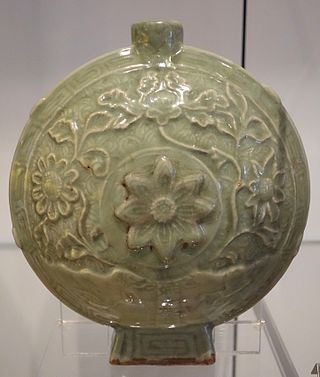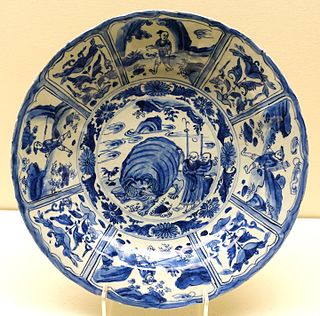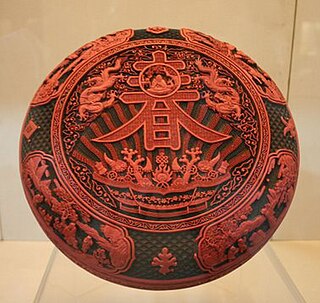Related Research Articles

Longquan celadon (龍泉青瓷) is a type of green-glazed Chinese ceramic, known in the West as celadon or greenware, produced from about 950 to 1550. The kilns were mostly in Lishui prefecture in southwestern Zhejiang Province in the south of China, and the north of Fujian Province. Overall a total of some 500 kilns have been discovered, making the Longquan celadon production area one of the largest historical ceramic producing areas in China. "Longquan-type" is increasingly preferred as a term, in recognition of this diversity, or simply "southern celadon", as there was also a large number of kilns in north China producing Yaozhou ware or other Northern Celadon wares. These are similar in many respects, but with significant differences to Longquan-type celadon, and their production rose and declined somewhat earlier.

The Percival David Foundation of Chinese Art holds a collection of Chinese ceramics and related items assembled by Percival David that are on permanent display in a dedicated gallery in Room 95 at the British Museum. The Foundation's main purpose is to promote the study and teaching of Chinese art and culture. The collection consists of some 1,700 pieces, mostly of Song, Yuan, Ming and Qing dynasty porcelain from the 10th century to the 18th. It includes a painting, Scroll of Antiquities.

Wen Zhengming, born Wen Bi, was a Chinese painter, calligrapher, and poet during the Ming dynasty. He was regarded as one of the Four Masters of Ming painting.

A gaiwan or zhong (盅) is a Chinese lidded bowl without a handle, used for the infusion of tea leaves and the consumption of tea. It was invented during the Ming dynasty. It consists of a bowl, a lid, and a saucer.

Charles Rees Howard Tripp, is an academic and author specializing in the politics and history of the Near and Middle East.
De-Sinicization is a process of eliminating or reducing Han Chinese cultural elements, identity, or consciousness from a society or nation. In modern contexts, it is often contrasted with the assimilation process of Sinicization.

The Ming dynasty considered Tibet to be part of the Western Regions. While the Ming dynasty at its height had some degree of influence in Tibet, the exact nature of their relations is under dispute by modern scholars. Analysis of the relationship is further complicated by modern political conflicts and the application of Westphalian sovereignty to a time when the concept did not exist. The Historical Status of China's Tibet, a book published by the People's Republic of China, asserts that the Ming dynasty had unquestioned sovereignty over Tibet by pointing to the Ming court's issuing of various titles to Tibetan leaders, Tibetans' full acceptance of the titles, and a renewal process for successors of these titles that involved traveling to the Ming capital. Scholars in China also argue that Tibet has been an integral part of China since the 13th century and so it was a part of the Ming Empire. However, most scholars outside China, such as Turrell V. Wylie, Melvyn C. Goldstein, and Helmut Hoffman, say that the relationship was one of suzerainty, Ming titles were only nominal, Tibet remained an independent region outside Ming control, and it simply paid tribute until the Jiajing Emperor, who ceased relations with Tibet.
Frederick Wade "Fritz" Mote was an American sinologist and a professor of History at Princeton University for nearly 50 years. His research and teaching interests focused on China during the Yuan and Ming dynasties. In collaboration with Denis C. Twitchett and John K. Fairbank he helped create The Cambridge History of China, a monumental history of China.

This carved lacquerware table in the Victoria and Albert Museum in London is from the Ming dynasty (1368–1644). It is unique in shape and decoration and is one of the most important objects from the period. It is one of the few surviving examples in the world of a major piece of furniture produced in the 'Orchard Workshop', the Imperial lacquer workshop set up in the early Ming period and situated to the north-west of the 'Forbidden City' compound in Peking.

The Confusions of Pleasure: Commerce and Culture in Ming China is an influential and frequently cited book which explores the economic and cultural history and the "influence of economic change on social and cultural life" in China during the Ming dynasty (1368–1644). The book is written by Timothy Brook, a Canadian historian of China (Sinology). The work won the Joseph Levenson Book Prize of 2000.

For millennia, Chinese archery has played a pivotal role in Chinese society. In particular, archery featured prominently in ancient Chinese culture and philosophy: archery was one of the Six Noble Arts of the Zhou dynasty ; archery skill was a virtue for Chinese emperors; Confucius himself was an archery teacher; and Lie Zi was an avid archer. Because the cultures associated with Chinese society spanned a wide geography and time range, the techniques and equipment associated with Chinese archery are diverse. The improvement of firearms and other circumstances of 20th century China led to the demise of archery as a military and ritual practice, and for much of the 20th century only one traditional bow and arrow workshop remained. However, at the beginning of the 21st century, there has been a revival in interest among craftsmen looking to construct bows and arrows, as well as a practice technique in the traditional Chinese style.

The Oriental Ceramic Society (OCS) is one of the leading international societies for the study and appreciation of Asian art, with a special interest in ceramics. However its wider focus is the study and appreciation of all aspects of oriental art, and over the last 90 years has served as one of the main bodies assisting the understanding of oriental art, and oriental ceramics in particular, by means of organising regular meetings, lectures and publications.

Chinese archaeology has been practiced since the Song dynasty (960–1279) with early practices of antiquarianism. Although native Chinese antiquarianism developed some rigorous methods of unearthing, studying, and cataloging ancient artifacts, the field of archaeology in China never developed into a branch of study outside of Chinese historiography. Native Chinese antiquarian studies waned after the Song period but were revived during the Qing dynasty (1644–1912). Rigorous standards of modern Chinese archaeology were first developed at the turn of the 20th century by Chinese archaeologists educated in the West and in the early Republic of China (1912–1949).
Luther Carrington Goodrich was an American sinologist and historian of China. A prolific author, he is perhaps best remembered for his work on the Dictionary of Ming Biography, 1368–1644.

Zhu Changfang, also known as the Jingyi Taoist was the last Prince of Lu (潞王). Zhu Changfang was an important member of the Imperial family of the Southern Ming dynasty during the Ming-Qing transition. He is notable both due to his historical political role and as a creative artist.

Carved lacquer or Qidiao is a distinctive Chinese form of decorated lacquerware. While lacquer has been used in China for at least 3,000 years, the technique of carving into very thick coatings of it appears to have been developed in the 12th century CE. It is extremely time-consuming to produce, and has always been a luxury product, essentially restricted to China, though imitated in Japanese lacquer in somewhat different styles. The producing process is called Diaoqi.

Yunnan under Ming rule refers to the rule of the Ming dynasty in Yunnan, which saw the continuation of the tusi system instituted during the Yuan dynasty, increasing centralization, and Han migration into Yunnan.
Willard J. Peterson is an American historian and sinologist. He is Gordon Wu '58 Professor of Chinese Studies, Emeritus, and Professor of East Asian Studies and History, Emeritus at Princeton University. His research specialties include early Chinese philosophy and Chinese intellectual history and history of science during the Ming and Qing dynasties.

Jessica Lucy Kilgour Harrison-Hall FSA is a British art historian, sinologist, curator and author. She is currently Head of the China section, Curator of Chinese Ceramics and Decorative Arts at the British Museum and is also Curator of the Sir Percival David Collection at the British Museum. She researches, lectures and writes about Chinese history and its global connections through visual and material culture.
References
- ↑ "Professor Craig Clunas". History of Art Department, University of Oxford. Archived from the original on 13 January 2015. Retrieved 27 January 2015.
- ↑ "CLUNAS, Prof. Craig" . Who's Who . Vol. 2024 (online ed.). A & C Black.(Subscription or UK public library membership required.)
- ↑ "Craig Clunas". www.trinity.ox.ac.uk. Retrieved 19 March 2021.
- ↑ "Professor Craig Clunas". www.gresham.ac.uk. Retrieved 19 March 2021.
- ↑ "In Our Time: The Ming Voyages". BBC Radio 4.
- ↑ "In Our Time: Romance of the Three Kingdoms". BBC Radio 4.
- ↑ "A History of the World: The David Vases" . Retrieved 27 January 2015.
- "Craig Clunas", in Jason Kuo ed, Discovering Chinese Painting: Dialogues with Art Historians (Dubuque Iowa, 2006), pp. 217–26